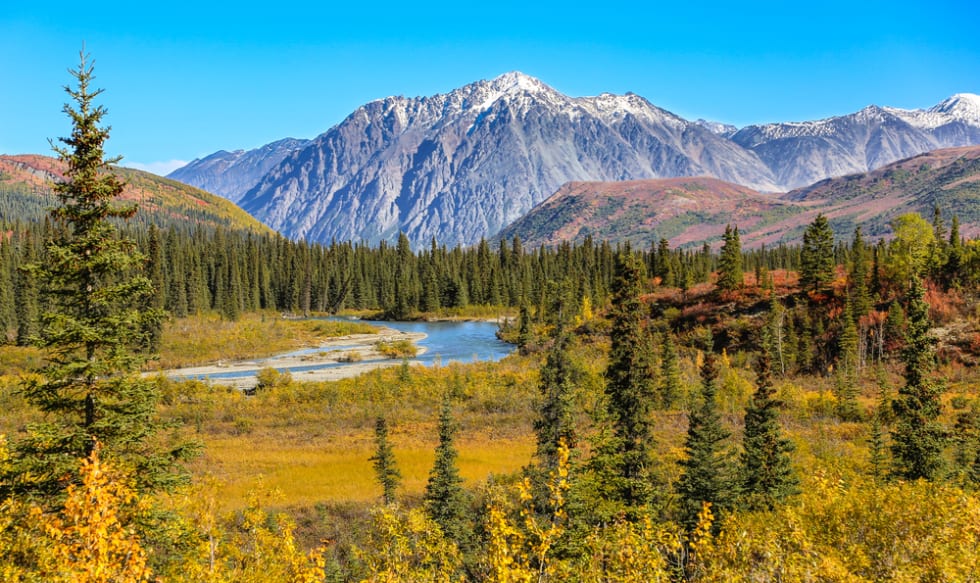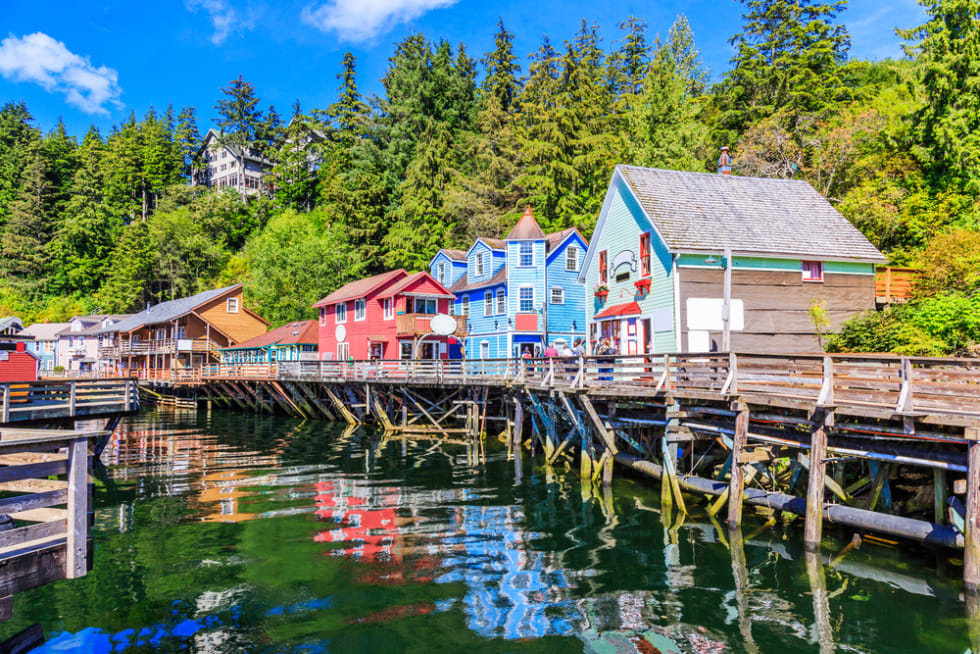Admirals Cove
- 8 units available
- 2 bed
- Amenities
In unit laundry, Patio / balcony, Granite counters, Dishwasher, Pet friendly, 24hr maintenance + more

Are you among the brave souls who wish to conquer The Last Frontier? Whether you're chasing job prospects or an adventurous lifestyle surrounded natural beauty, the state of Alaska has plenty of incentives to encourage any prospective renter to put down roots.
If you're thinking about making the move, you'll want to make sure that Alaska is within your budget. This guide breaks down cost of living, including rent prices/housing, utilities, average monthly spending in Alaska's biggest city, and more.
If you've fallen in love with Alaska's charming appeal, then it's crucial to understand what to expect financially. This guide will break down everything you need to know about the cost of living in Alaska. Let's dive in!
The cost of living is currently 16.5% higher than the average U.S. city in our database. Note that for major cities in Alaska, the most and least expensive cities have very similar COL rates. Currently, the overall median rent in the city stands at $1,695, roughly the same as last month.
Utilities are among your most costly expenses in Alaska, with the overall data breaking down accordingly:
| Cost of Living | Alaska | U.S. |
|---|---|---|
| Overall | 116.5 | 100 |
| Grocery | 141.7 | 100 |
| Health | 127.3 | 100 |
| Housing | 100.6 | 100 |
| Median Home Cost | $336,100 | $338,100 |
| Utilities | 169.8 | 100 |
| Transportation | 98.2 | 100 |
| Miscellaneous | 112.4 | 100 |
When talking about the cost of living in Alaska, it's important to understand that Alaska is the least densely populated state in the US. As a result, [Anchorage] (https://www.apartmentlist.com/ak/anchorage), which is home to almost 40% of the state's population, offers a perfect sample of the state's cost of living as a whole.
The most expensive city in Alaska is Unalaska, where the cost of living is 36.4% higher than in the rest of the U.S and 17.1% higher compared to the state average. Here's how the costs in Unlaska compare to the state and national average.
| Cost of Living | Unalaska | Alaska | U.S. |
|---|---|---|---|
| Overall | 136.4 | 116.5 | 100 |
| Grocery | 316.5 | 141.7 | 100 |
| Health | 129.7 | 127.3 | 100 |
| Housing | 168 | 100.6 | 100 |
| Median Home Cost | $445,900 | $336,100 | $338,100 |
| Utilities | 200.4 | 169.8 | 100 |
| Transportation | 74.9 | 98.2 | 100 |
| Miscellaneous | 97.7 | 112.4 | 100 |
The major city in Alaska with the lowest cost of living is Fairbanks, where it's 10.7% lower compared to the state average, but still 4.0% higher than the national average. With more urban density, you are also more likely to find an apartment rental in Anchorage than anywhere else in Alaska.
| Cost of Living | Fairbanks | Alaska | U.S. |
|---|---|---|---|
| Overall | 104 | 116.5 | 100 |
| Grocery | 133 | 141.7 | 100 |
| Health | 128.1 | 127.3 | 100 |
| Housing | 82.9 | 100.6 | 100 |
| Median Home Cost | $275,600 | $336,100 | $338,100 |
| Utilities | 134.1 | 169.8 | 100 |
| Transportation | 75.1 | 98.2 | 100 |
| Miscellaneous | 136.3 | 112.4 | 100 |
Our latest rent report shows that a one-bedroom apartment in Anchorage, AK is $1,214 a month, reflecting a 3.5% increase year-over-year. However, rents haven't really changed month-over-month. Anchorage’s rent growth over the past year has is similar to the state average (2.6%) and has outpaced the national average (-0.6%).
According to our latest rent report from December, 2024, the median rent for a two-bedroom apartment in Anchorage, Alaska is $1,659. Despite being relatively flat since last month, rents are up 3.5% year-over-year.
The average Anchorage resident spends $5,140 a month, which comes out to around $58,000 a year. Similarly, we can use the average rent cost of a one-bedroom apartment in Anchorage, which is is $1,214, and a budgeting rule to determine what a comfortably salary would be for a renter. To have enough money to cover bills, entertainment, and savings, you would need to keep rent under 30% of your total income before taxes, which means you should earn around $48,560 a year, $4,046.67 a month, or $23.08 an hour. However, our data suggests that real residents are spending a bit more, so you should take that into consideration when you budget.
MIT uses a more complex living wage calculation to determine that you would need to earn $23.26 an hour, or $48,381 annually before taxes to live in Anchorage. However, that amount does not include entertainment, student loan repayments, or savings.
We can also consider data from the U.S. Census Bureau. They report the median household income in Alaska as $86,370 a year, which is significantly above what you would need to follow the 30% rule for the median rent in areas like Anchorage. Keep in mind that while housing is relatively affordable in Alaska, food and utilities are often much higher.
If you're considering buyin ga home in Alaska, you'll also find home prices are rising.
| City | Median Home Price |
|---|---|
| Anchorage, AK | $275,600 |
| Juneau, AK | $456,700 |
| Sitka, AK | $438,400 |
| Fairbanks, AK | $275,600 |
While Alaska does offer public transportation options, state residents are typically used to getting around in a personal vehicle. Over 90% of trips taken in Anchorage occur within a personal vehicle.
This explains the high annual transportation expense in the city. MIT's living expense data puts the annual transportation expenses for a single person at $11,519. For a family of four with two children, transportation expenses increase to $19,322 a year.
For those who prefer to forego that expense, some cities in Alaska, like Anchorage, offer a few options that may help to offset costs. The RideShare Program offers residents a way to get around via a "vanpool," or group of five or more riders who commute and travel at the same time. Prices will vary depending on your commute.
It's also possible to hop on a bus and ride to your destination for the low fare of $2 per single trip, $60 for a monthly pass, or $660 per year via the People Mover system. Whichever way you slice it, $660 is a lot cheaper than the typical annual transportation cost of nearly $5,000.

Next to housing costs, food costs can be a major expense for Alaskan residents. The average Alaskan resident spends $5,219 annually or $434.92 monthly on groceries. For a family of four, food expenses increase to $15,338 annually or $1,278.62 monthly. Compared to the rest of the country, food prices are quite high in Alaska, reflecting the higher cost of living and shipping logistics that are unique to the aera.
The good news is you can save on groceries by shopping strategically at stores like Fred Meyer or Costco, both of which are popular for their bulk deals and member discounts. Local farmers' markets, such as the Anchorage Farmers' Market, can also offer fresh produce at competitive prices, especially during the summer months.
It's also important to consider expanding your budget to indulge in local specialties? From fresh-caught salmon to hearty reindeer sausages, Alaskan cuisine offers plenty of fresh seafood and game meat temptations. Be sure to factor in dining out as a treat for your taste buds and your budget! Here's a breakdown of the cost of a three-course meal in a mid-tier restaurant in Alaska.
The average adult resident of Alaska spends $3,218 on healthcare costs annually. A family of four spends $9,330 in the same period.
Depending on your circumstances, your relationship with healthcare may be as simple as heading in for your yearly physical, though you may require more frequent trips. Regardless, it's crucial to find an affordable health insurance plan that meets your and your family's needs.
Visit the federal Healthcare Marketplace to find an affordable health insurance plan with coverage in your state. You can also take advantage of one of the many public health centers across the state of Alaska to access affordable healthcare near you. These centers typically charge fees on a sliding scale based on family size and income.
If you’re moving from out of state, be sure to file a report via the marketplace letting them know that you’ve moved and will need to transfer your coverage or find a new plan. If not, you may be subject to a lapse in coverage.
It's no secret that Alaska gets cold, but how does its extreme weather impact utility costs? Here is how the costs break down for electricity, heating, cooling, water, and garbage for 915 sq ft Apartment in some of Alaska's major ciites.
The United States average utility bill of $206.81 to get an idea of how to compare.You can beat some of the extreme weather by living in a more southern city like Anchorage or Juneau. However, if you choose to live in Fairbanks, which lies in the interior of Alaska, expect more extreme weather.
For most Alaskan residents, the bulk of their utility bills stem from the necessary cost of heating their homes in the winter months.
Overall, light/electricity may be your only non-bundled out-of-pocket utility expense. You'll likely need some sort of internet connection and cell phone service, which can tack on about $200 or more a month to your estimated utility bill. You'll find Internet prices are higher in Alaska because of its remote location, low population density, and the high cost of building and maintaining infrastructure.

Whether you're a rugged mountain lover or a fitness fanatic looking to break a sweat in the Alaskan winter, you've got options. Alaska is brimming with fitness and entertainment opportunities for residents to take advantage of at any time. Here are a few fitness and entertainment options in Alaska and their costs.
Staying fit in Alaska can be as simple as heading out your front door. With so much incredible natural scenery and some parts of the year boasting well over 18 hours of sunlight, whether you walk, run, bike, or skate, the Alaskan scenery will provide the perfect backdrop to your workout.
However, if you prefer to workout in a group setting or gym, memberships can be a bit costly. Here's a cost breakdown of an annual gym membership in Alaska:
One of the perks of living in a state that boasts such a robust outdoors scene, is, well, the outdoor scene. You won't find tons of cities and concrete skyscrapers dominating the landscape in Alaska, though you will find tons of forests, mountains, and bodies of water to explore. One of the most popular outdoor spots in Alaska is Denali State Park.
You can view the Alaska and Denali Ranges in all their natural glory from pretty much any vantage point in the state park.
If you fancy yourself more of an explorer, take a trail. You'll likely see some of the park's wildlife. That includes birds, flying squirrels, wolves, caribou, and more.
Keep in mind that bears, wolves, and other predatory animals are extremely dangerous. You should not approach wildlife under any circumstances.
This free state park attracts all sorts of adventurers. You’ll see fishermen, backpackers, rock climbers, kayakers, and more.
A little-known fact about Alaska is that it boasts quite an impressive collection of museums dedicated to science, art, North America, and more. These museums are dotted within the major Alaskan cities, so you and your family can take a trip to your city's local museum.
Luckily, museums are a low-cost, family-friendly attraction. Here’s a breakdown of the costs of museum tickets in Alaska.

When you're creating your Alaskan budget, it's important to be as detailed as possible. Though there are common expenses that you'll have to account for wherever you move, all locations have their own unique expenses. They can be difficult to predict without having lived there for some time.
Luckily, we've got you covered. Here are some of the hidden costs of living in Alaska.
Living in Alaska is definitely a unique experience in its own right. However, as long as you’ve got the right budget to live comfortably in the state, there’s no reason that you can’t make a successful move to Alaska. Take our quiz to get started on your journey to finding your Alaska dream apartment!
As of December 2024, The average one-bedroom apartment currently listed in Anchorage costs $1,214. The two-bedroom average is $1,659. Although rents are relatively stable month-over-month in Alaska, they're up 3.5% since this time last year.
As of December, 2024, the lowest median rent in Alaska is in Anchorage where 1-bedroom apartments are about $1,214 a month.
In Anchorage, where over 40% of Alaska's population is located, the average resident spends $5,140 a month, per month as of December 2024. Food in Alaska costs an average single adult $5,219 a year, and a family of four will spend around $15,338. Residents spend around $11,519 a year on transportation, or $19,322 for a family of four with two working adults. For healthcare, a single adult will pay around $3,218 and a family of four spends $9,330.
Alaska is 3,178 miles away from California It takes 56 hours to get to California from Alaska by car, 275 hours by bike, and 730 hours by foot.
According to the U.S. Census Bureau, the population of Alaska is 733,406. It is the largest state in the country by area, bigger than the next three states combined, including Texas, California, and Montana.


In unit laundry, Patio / balcony, Granite counters, Dishwasher, Pet friendly, 24hr maintenance + more
In unit laundry, Patio / balcony, Dishwasher, Pet friendly, 24hr maintenance, Garage + more